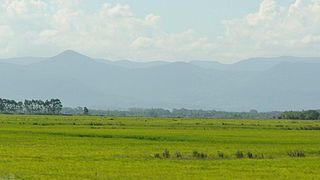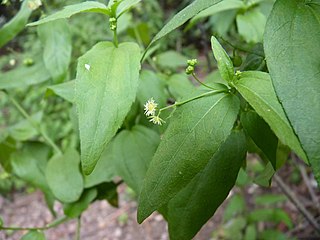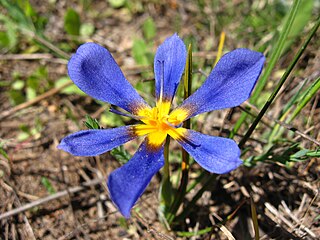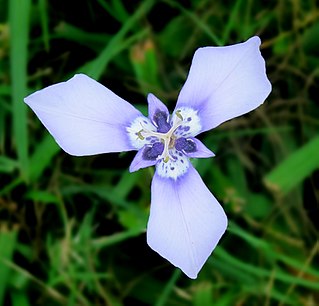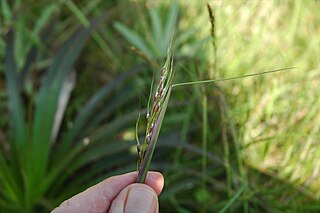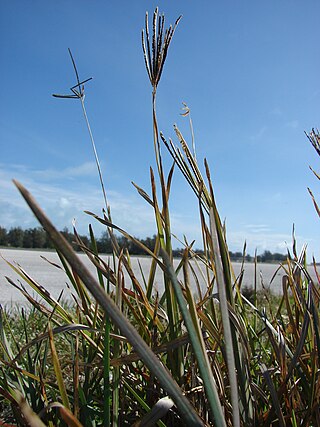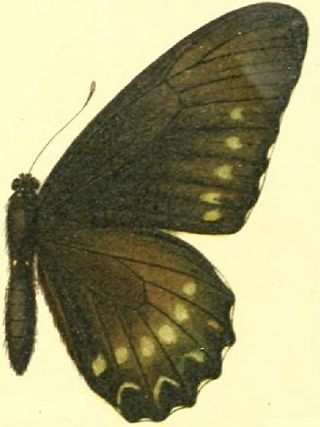| Cypella | |
|---|---|
 | |
| Cypella coelestis [1] | |
| Scientific classification | |
| Kingdom: | Plantae |
| Clade: | Tracheophytes |
| Clade: | Angiosperms |
| Clade: | Monocots |
| Order: | Asparagales |
| Family: | Iridaceae |
| Subfamily: | Iridoideae |
| Tribe: | Tigridieae |
| Genus: | Cypella Herb. |
| Type species | |
| Cypella herbertii (Lindley) Herbert | |
| Synonyms [2] | |
| |
Cypella is a genus of herbaceous, perennial and bulbous plants in the family Iridaceae. It is distributed in South America, from Peru and Brazil to Northern Argentina. [2] The genus name is likely derived from the Greek word kyphella, meaning "hollow of the ear", and alludes to the shape of the inner tepals. [3]
Contents
- Species [2]
Based on DNA and morphological features, the South American genera Kelissa and Onira are now included in Cypella. [4]
- Cypella amambaica Ravenna, Onira 12: 4 (2009). Paraguay
- Cypella aquatilis Ravenna, Nordic J. Bot. 1: 489 (1981). S. Brazil.
- Cypella armosa Ravenna, Wrightia 7: 20 (1981). Paraguay to NE. Argentina.
- Cypella boliviana Huaylla, Kew Bull. 67: 297 (2012). Bolivia
- Cypella brasiliensis (Baker) Roitman & J.A.Castillo, Darwiniana 45: 238 (2007). southern Brazil
- Cypella catharinensis Ravenna, Onira 10: 39 (2005). Brazil (Santa Catarina).
- Cypella craterantha Ravenna, Revista Inst. Munic. Bot. 2: 52 (1964). Peru (Cajamarca).
- Cypella crenata (Vell.) Ravenna, Bol. Soc. Argent. Bot. 10: 312 (1965). Brazil (SE. Minas Gerais to São Paulo).
- Cypella curuzupensis Ravenna, Wrightia 7: 19 (1981). Paraguay.
- Cypella discolor Ravenna, Wrightia 7: 16 (1981). S. Brazil.
- Cypella elegans Speg., Physis (Buenos Aires) 2: 43 (1917). Argentina (Jujuy Province).
- Cypella exilis Ravenna, Nordic J. Bot. 1: 492 (1981). E. & S. Brazil to NE. Argentina.
- Cypella fucata Ravenna, Wrightia 7: 18 (1981). S. Brazil to NE. Uruguay.
- Cypella geniculata (Klatt) Ravenna, Revista Inst. Munic. Bot. 2: 53 (1964). Brazil.
- Cypella hauthalii (Kuntze) R.C.Foster, Contr. Gray Herb. 171: 23 (1950). SE. Paraguay to Argentina (Corrientes, Misiones).
- Cypella herbertii (Lindl.) Herb., Bot. Mag. 53: t. 2637 (1826). S. Brazil to NE. Argentina.
- Cypella laeta Ravenna, Wrightia 7: 13 (1981). NE. Argentina.
- Cypella lapidosa Ravenna, Wrightia 7: 21 (1981). Argentina (Corrientes).
- Cypella laxa Ravenna, Wrightia 7: 15 (1981). S. Brazil.
- Cypella luteogibbosa Deble, Phytotaxa 71: 60 (2012). Rio Grande do Sul
- Cypella magnicristata Deble, Phytotaxa 71: 63 (2012). Rio Grande do Sul
- Cypella mandonii Rusby, Mem. Torrey Bot. Club 6: 125 (1896). Bolivia.
- Cypella oreophila Speg., Physis (Buenos Aires) 2: 44 (1917). NW. Argentina.
- Cypella osteniana Beauverd, Bull. Soc. Bot. Genève 14: 165 (1922 publ. 1923). Uruguay.
- Cypella pabstiana Ravenna, Wrightia 7: 18 (1981). Brazil (Paraná).
- Cypella pusilla (Link & Otto) Benth. & Hook.f. ex B.D.Jacks., Index Kew. 1: 689 (1893). S. Brazil.
- Cypella suffusa Ravenna, Onira 12: 1 (2009). Argentina (Misiones Province)
- Cypella trimontina Ravenna, Onira 12: 2 (2009). Argentina (Corrientes Province)
- Cypella unguiculata (Baker) Roitman & J.A.Castillo - Uruguay, Rio Grande do Sul
- Cypella yatayphila Ravenna, Onira 12: 3 (2009). Argentina (Entre Ríos Province)
- formerly included
- Cypella gigantea Klatt = Phalocallis coelestis (Lehm.) Ravenna

